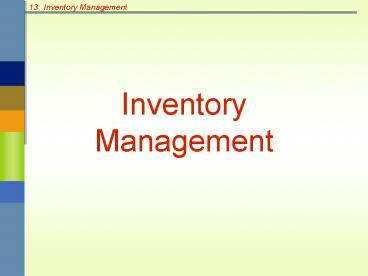Inventory Management - PowerPoint PPT Presentation
1 / 36
Title:
Inventory Management
Description:
(manufacturing firms) or merchandise (retail stores) 13. Inventory Management ... TC = 13. Inventory Management. Cost Minimization Goal. Order Quantity (Q) ... – PowerPoint PPT presentation
Number of Views:32
Avg rating:3.0/5.0
Title: Inventory Management
1
- Inventory Management
2
Types of Inventories
- Raw materials purchased parts
- Partially completed goods called work in
progress - Finished-goods inventories
- (manufacturing firms) or merchandise (retail
stores)
3
Types of Inventories (Contd)
- Replacement parts, tools, supplies
- Goods-in-transit to warehouses or customers
4
Functions of Inventory
- To meet anticipated demand
- To smooth production requirements
- To decouple components of the production-distribut
ion - To protect against stock-outs
5
Functions of Inventory (Contd)
- To take advantage of order cycles
- To help hedge against price increases or to take
advantage of quantity discounts - To permit operations
6
Key Inventory Terms
- Lead time time interval between ordering and
receiving the order - Holding (carrying) costs cost to carry an item
in inventory for a length of time, usually a year - Ordering costs costs of ordering and receiving
inventory - Shortage costs costs when demand exceeds supply
7
ABC Classification System
Figure 13-1
- Classifying inventory according to some measure
of importance and allocating control efforts
accordingly. - A - very important
- B - mod. important
- C - least important
8
Economic Order Quantity Models
- Economic order quantity model
- Economic production model
- Quantity discount model
9
Assumptions of EOQ Model
- Only one product is involved
- Annual demand requirements known
- Demand is even throughout the year
- Lead time does not vary
- Each order is received in a single delivery
- There are no quantity discounts
10
The Inventory Cycle
Figure 13-2
11
Total Cost
12
Cost Minimization Goal
Figure 13-4
13
Minimum Total Cost
- The total cost curve reaches its minimum where
the carrying and ordering costs are equal.
14
Economic Production Quantity
15
Economic Production Quantity Assumptions
- Only one item is involved
- Annual demand is known
- Usage rate is constant
- Usage occurs continually
- Production rate is constant
- Lead time does not vary
- No quantity discounts
16
Economic Production Quantity
17
Quantity Discounts
18
Total Costs with PD
Figure 13-7
19
Total Cost with Constant Carrying Costs
20
Total Cost with Constant Carrying Costs
21
Total Cost with Variable Carrying Costs
22
Total Cost with Variable Carrying Costs
23
When to Reorder with EOQ Ordering
- Reorder Point - When the quantity on hand of an
item drops to this amount, the item is reordered - Safety Stock - Stock that is held in excess of
expected demand due to variable demand rate
and/or lead time. - Service Level - Probability that demand will not
exceed supply during lead time. - SL100-stockout risk
24
Reorder Point (ROP)
25
Reorder Point (ROP)
26
Reorder Point (ROP)
27
Shortage and Service Level
28
Fixed-Order-Interval Model
- Orders are placed at fixed time intervals
- Order quantity for next interval?
- Suppliers might encourage fixed intervals
- May require only periodic checks of inventory
levels
29
Fixed-Order-Interval Model
30
Stockout Risk
31
Fixed-Interval Benefits
- Tight control of type A items
- Items from same supplier may yield savings in
- Ordering
- Packing
- Shipping costs
- May be practical when inventories cannot be
closely monitored
32
Fixed-Interval Disadvantages
- Requires a larger safety stock
- Increases carrying cost
- Costs of periodic reviews
33
Single Period Model
- Single period model model for ordering of
perishables and other items with limited useful
lives - Shortage cost generally the unrealized profits
per unit - Excess cost difference between purchase cost and
salvage value of items left over at the end of a
period
34
Single Period Model
- Cshortage Cs revenue per unit - cost per unit
- Cexcess Ce original cost per unit - salvage
value per unit
35
Single Period Model
- Continuous stocking levels
- Identifies optimal stocking levels
- Optimal stocking level balances unit shortage and
excess cost - Discrete stocking levels
- Service levels are discrete rather than
continuous - Desired service level is equaled or exceeded
36
Operations Strategy
- Too much inventory
- Tends to hide problems
- Easier to live with problems than to eliminate
them - Costly to maintain
- Wise strategy
- Reduce lot sizes
- Reduce safety stock































